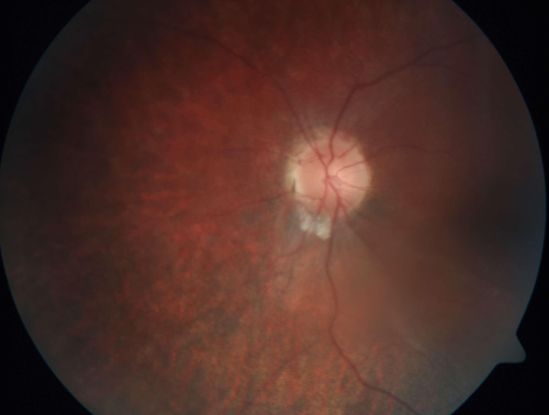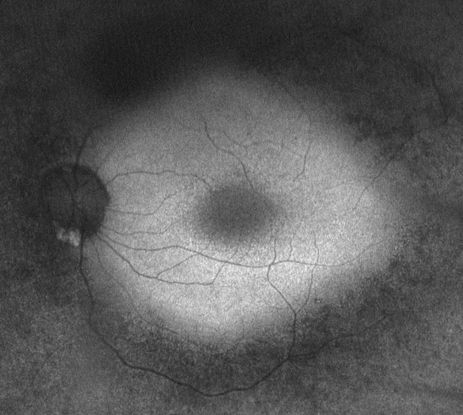AUG 26, 2016
By Arif O. Khan, MD, and Elias I. Traboulsi, MD
A Compendium of Inherited Disorders and the Eye, Oxford University Press
Genetics
OMIM Numbers
Inheritance
Gene/Gene Map
- 2p13, ALMS1 gene (OMIM 606844)
Epidemiology
- Alström syndrome is considered very rare, but the condition may be underdiagnosed. It is more common among French Acadians of Yarmouth County, Nova Scotia, and Louisiana and in Saudi Arabia.
Clinical Findings
- Patients with Alström syndrome generally have early-onset retinal dystrophy, typically of the cone-rod variety, that can be misdiagnosed as Leber congenital amaurosis; some, however, present in young adulthood with a diagnosis of retinitis pigmentosa, especially if the other clinical findings are mild or absent. Asking questions about hearing loss, diabetes, or other systemic features is critical to put the clinician on the right track for the correct diagnosis. Infantile dilated cardiomyopathy, which can be transient, is common in infancy. Later juvenile-onset features include deafness, obesity, and diabetes mellitus from resistance to insulin.
- As opposed to patients with Bardet-Biedl syndrome, there is no polydactyly, mental retardation, or hypogonadism.
- Other less common clinical features include a slowly progressive chronic nephropathy, acanthosis nigricans (Figure 1), diabetes insipidus, and liver failure and cirrhosis.
- Unlike other systemic ciliopathies, which are typically associated with multiple different gene mutations, Alström syndrome is specific for bi-allelic mutation in one gene, ALMS1.

Figure 1. Back of the neck of a patient with Alström syndrome showing acanthosis nigricans.
Ocular Findings
- Photophobia and nystagmus, present early in life, are the most consistent findings of the disease. There are no pathognomonic retinal findings, which are generally ones of optic pallor, attenuation of retinal blood vessels, and pigmentary changes (Figure 2). Hyperopia is common. Electroretinography shows severe cone impairment with mild or no rod involvement early in the disease, with progression to more severe rod dysfunction as patients get older.
- Russell-Eggitt et al. found 37 cases of Alström syndrome in the world literature since 1959. Of 22 patients admitted to the Great Ormond Street Hospital for Children in London, 18 had infantile cardiomyopathy. These authors confirmed the severe and progressive infantile retinal dystrophy with better preserved rod than cone function. Visual acuity decreased to less than 20/200 by 10 years of age and no light perception by 20 years of age.
Figure 2A.

Figure 2B.

Figure 2. Fundus photograph (A) and fundus autofluorescence (B) of a young adult with Alström syndrome. Note mild optic atrophy, attenuated blood vessels and RPE changes most prominent on fundus autofluorescence.
Therapeutic Considerations
- Alström syndrome should be considered in children and infants with obesity and a cone-rod dystrophy, especially in the presence of a dilated cardiomyopathy. Early diagnosis can help to decrease morbidity and mortality from later-onset systemic features. The appropriate specialists should be consulted to manage the multiple facets of this systemic disorder.
References
- Alström CH, Hallgren B, Nilsson LB, Asander H. Retinal degeneration combined with obesity, diabetes mellitus and neurogenous deafness: a specific syndrome (not hitherto described) distinct from the Laurence-Moon-Biedl syndrome. A clinical endocrinological and genetic examination based on a large pedigree. Acta Psychiat Neurol Scand. 1959; 34 (suppl. 129): 1-35.
- Awazu M, Tanaka T, Sato S, et al. Hepatic dysfunction in two sibs with Alström syndrome: case report and review of the literature. Am J Med Genet. 1997; 69: 13-16.
- Collin GB, Marshall JD, Cardon LR, Nishina PM. Homozygosity mapping of Alström syndrome to chromosome 2p. Hum Mol Genet. 1997; 6: 213-219.
- Girard D, Petrovsky N. Alström syndrome: insights into the pathogenesis of metabolic disorders. Nat Rev Endocrinol. 2011; 7:77-88.
- Hearn T, Renforth GL, Spalluto C, et al. Mutation of ALMS1, a large gene with a tandem repeat encoding 47 amino acids, causes Alström syndrome. Nat Genet. 31: 79-83, 2002.
- Khan AO, Bifari IN, Bolz HJ. Ophthalmic features of children not yet diagnosed with Alström syndrome. Ophthalmology. 2015 Aug;122(8):1726-7.e2.
- Michaud JL, Héon E, Guilbert F, et al. Natural history of Alström syndrome in early childhood: onset with dilated cardiomyopathy. J Pediatr. 1996; 128: 225-229.
- Millay RH, Weleber RG, Heckenlively JR. Ophthalmologic and systemic manifestations of Alström's disease. Am J Ophthalmol. 1986; 102: 482-490.
- Russell-Eggitt IM, Clayton PT, Coffey R, , Kriss A, Taylor DS, Taylor JF. Alström syndrome: report of 22 cases and literature review. Ophthalmology. 1998; 105: 1274-1280.
Traboulsi EI. Compendium of Inherited Disorders and the Eye. New York: Oxford University Press; 2005. Adapted with permission.